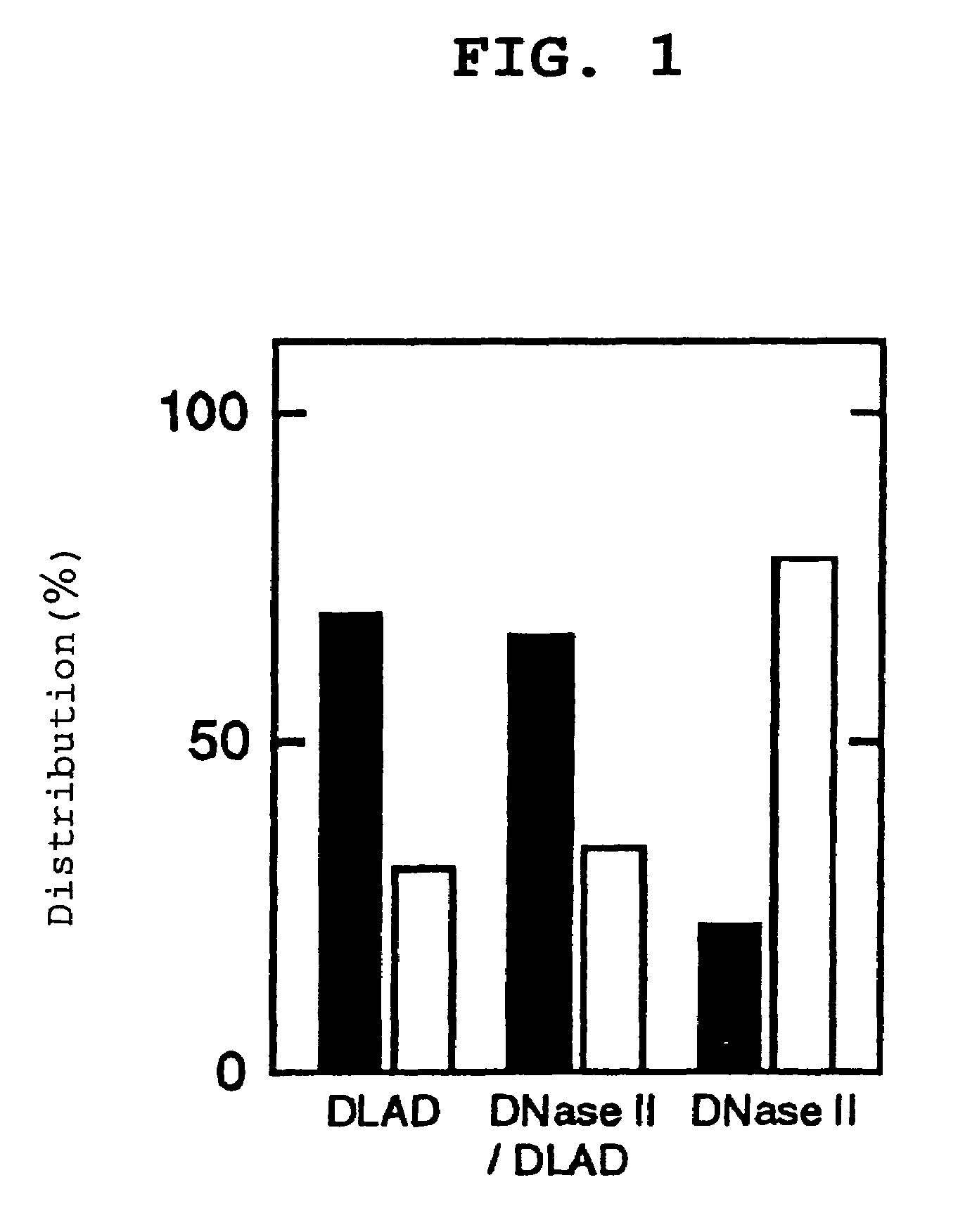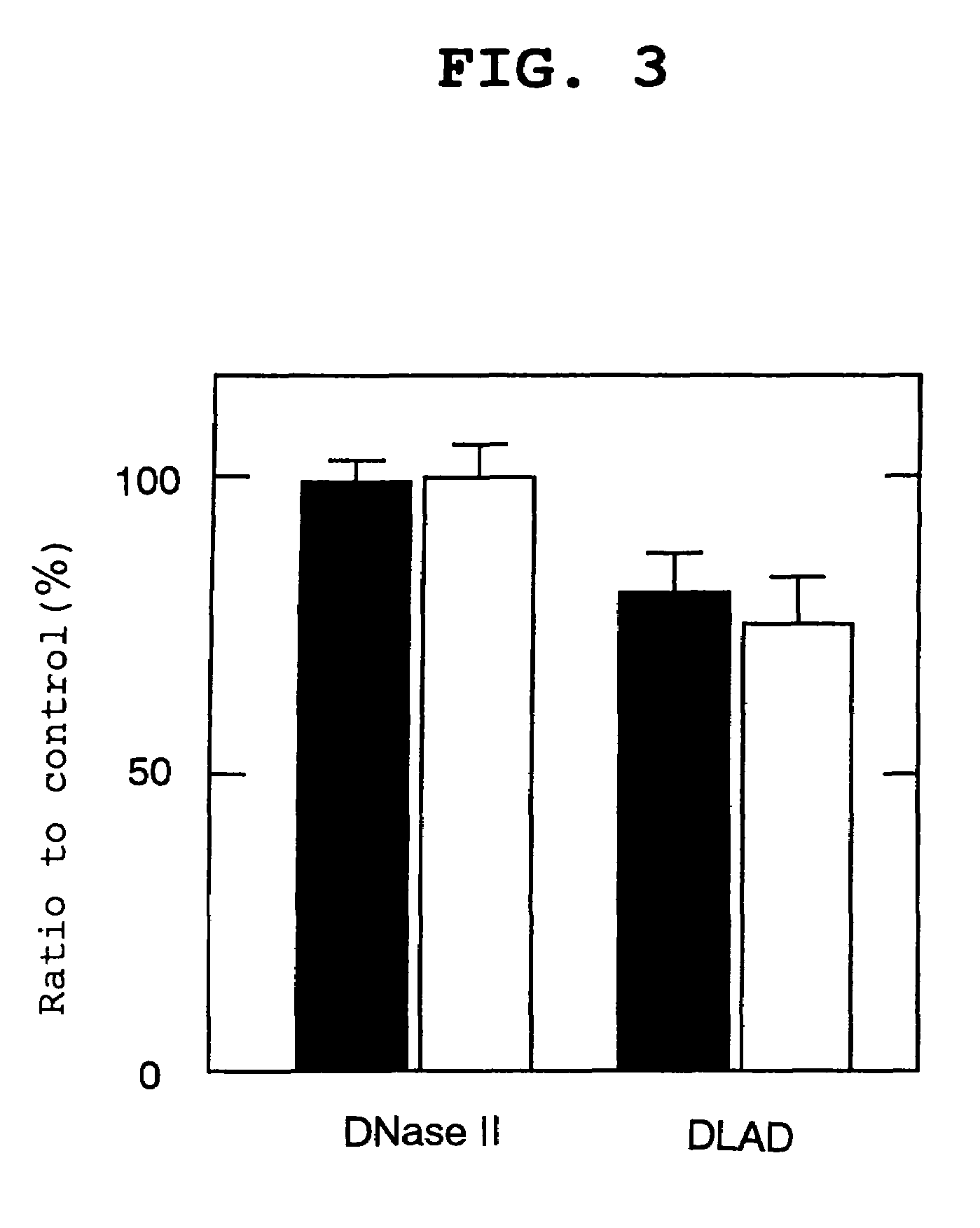Deoxyribonuclease, gene encoding same and use thereof
a technology of deoxyribonuclease and gene, applied in the field of deoxyribonuclease, gene encoding same, can solve the problems of unsatisfactory dnase and hardly showing any therapeutic effect of dnase i
- Summary
- Abstract
- Description
- Claims
- Application Information
AI Technical Summary
Benefits of technology
Problems solved by technology
Method used
Image
Examples
example 1
Cloning and Sequence Analysis of Mouse DLAD cDNA
[0120]The EST subdivision of the NCBI GenBank database was screened for EST encoding an amino acid sequence homologous to the deduced amino acid sequence of human DNase II (GenBank AF060222) using the tblastn program. As a result, a mouse EST clone (GenBank AI048641) was identified. Based on the sequence of the EST clone, the following two oligonucleotide primers (GSP2 / mD and GSP1 / mD) were synthesized. Furthermore, the following oligonucleotide (AP1) was synthesized as a linker primer. GSP2 / mD:
[0121]
(Sequence Listing, SEQ ID NO: 5)5′-AATGAATATGGTGAAGCTGTGGACTGG-3′
(sequence identical to the nucleotide sequence of the nucleotide Nos. 300 to 326 of the nucleotide sequence shown in Sequence Listing, SEQ ID NO: 2) GSP1 / mD:
[0122]
(Sequence Listing, SEQ ID NO: 6)5′-CCATCGTTGTATATTAGATAGGCTGTG-3′
(sequence complementary to the nucleotide sequence of the nucleotide Nos. 509 to 535 of the nucleotide sequence shown in Sequence Listing, SEQ ID NO: 2...
example 2
Tissue Distribution of DLAD mRNA
[0130]Northern blot analysis was performed to assess the expression of DLAD mRNA in various mouse tissues. Total RNA was extracted from each tissue (brain, thymus, lung, heart, liver, stomach, small intestine, spleen, kidney and testis) of adult mouse with TRIzol reagent (Gibco BRL). Each RNA aliquot (15 μg) was subjected to 1% agarose-formamide gel electrophoresis and blotted onto a Biodyne-A membrane (Paul). This membrane was subjected to the hybridization with a 32P-labeled probe, obtained by random priming of Xho I digestion fragment of pcDLAD-Myc-His (see below), which is a vector carrying the DNA encoding a DLAD-Myc fusion protein with a histidine tag, in hybridization solution consisting of 5×SSPE, 5× Denhardt's solution, 50% formamide, 0.1% SDS and 100 μg / ml heat-denatured salmon sperm DNA at 42° C. overnight. The hybridization solution was removed after the reaction, and the membrane was washed with 0.1×SSC, 0.1% SDS at 50° C. and exposed to ...
example 3
Localization of DLAD Protein
[0131]The primary structure analysis of DLAD in Example 1 revealed that the primary translation product of DLAD has a hydrophobic domain satisfying the requirement for a signal peptide at the N terminus. That is, it was suggested that DLAD was a secretory protein. Then, to confirm this, a DLAD expression vector was introduced into a human cultured cell followed by comparison of the presence ratio of intracellular / extracellular DLADS. The subcellular localization of DLAD present within the cell was also analyzed.
(1) Construction of DLAD Expression Vector
[0132]RT-PCR reaction was performed with C57black / 6 mouse liver-derived poly A(+) RNA as a template, using the following pair of primers to generate a cDNA fragment containing DLAD ORF without termination codon, and the resulting cDNA fragment was subcloned into pBLUESCRIPT KS+.
Senseprimer:
[0133]
(Sequence Listing, SEQ ID NO: 9)5′-CTCGAGCCACCATGACAGCAAAGCCTCTAAGAACA-3′
(sequence with a linker sequence contain...
PUM
 Login to View More
Login to View More Abstract
Description
Claims
Application Information
 Login to View More
Login to View More - R&D
- Intellectual Property
- Life Sciences
- Materials
- Tech Scout
- Unparalleled Data Quality
- Higher Quality Content
- 60% Fewer Hallucinations
Browse by: Latest US Patents, China's latest patents, Technical Efficacy Thesaurus, Application Domain, Technology Topic, Popular Technical Reports.
© 2025 PatSnap. All rights reserved.Legal|Privacy policy|Modern Slavery Act Transparency Statement|Sitemap|About US| Contact US: help@patsnap.com



